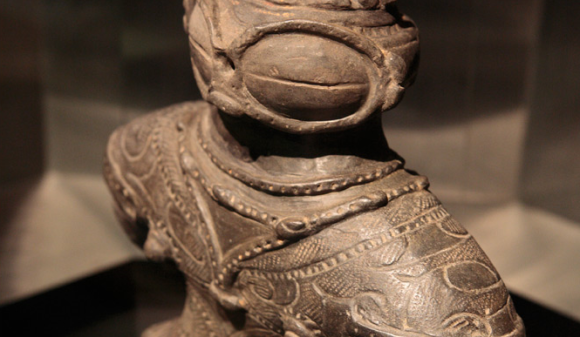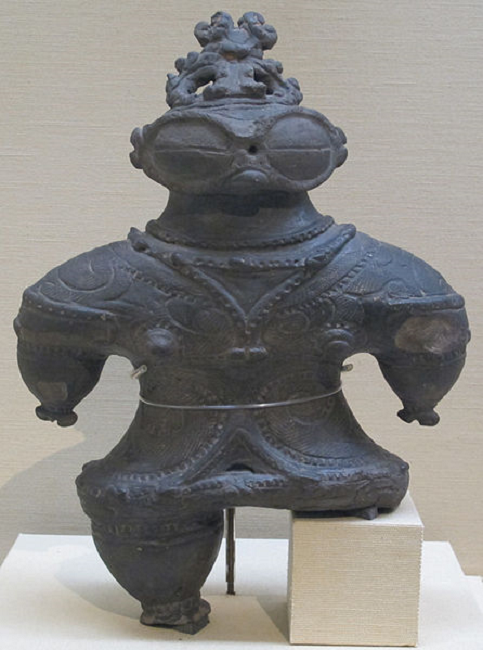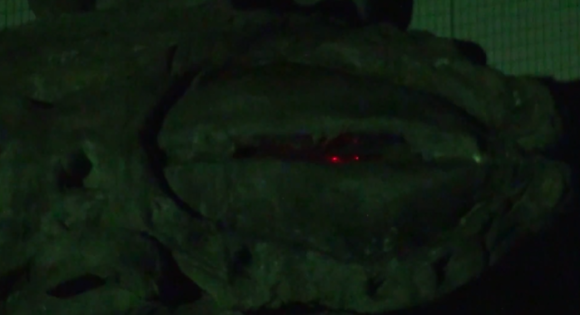The major train stations in urban Japan almost seem like small cities, packed with restaurants, hotels, and shopping space. Things are usually pretty different out in the countryside, though, where many rail stops are little more than an awning with a short bench to sit on while you wait for the trains to roll in.
We say rural stations are “usually” simple, though, because in one town up north in Aomori Prefecture, you’ll find a station guarded by what looks like a massive alien.
Actually, the inspiration for Kizukuri Station’s unique facade didn’t come from outer space, but from below the earth. Archeological digs in Japan’s northeastern Tohoku region sometimes turn up clay figures called dogu. While their is unknown, their cultural value is unmistakable, as most were crafted some 2,500 years ago. The town of Tsugaru, where Kizukuri Station is located, was the site where one particularly pristine example, the Shakoji Dogu, was found in 1887.
Like so many other figures that achieve fame, though, the Shakoji Dogu made its way to the capital, and is now housed in the Tokyo National Museum. Tsugaru does still have a replica in its Karuko Archeological Hall, but given that it’s a modern recreation, the most famous dogu in town is now the gigantic 17-meter (56-foot) example built into the wall of Kizukuri Station.
【青森・木造駅】JR東日本、五能線の駅。列車発着に合わせてコンクリート製の巨大マスコット土偶シャコちゃんの目から赤い「いらっしゃいビーム」を点滅発射していたが、子供のトラウマになると不評だったため、現在はビーム自粛中。 pic.twitter.com/psp12rTPKz
— B面 (B級スポット・珍スポットガイド) (@bii_men) November 9, 2014
Built at a rumored cost of some 100 million yen (US$870,000), the concrete figure has been nicknamed Shako-chan. The designers did a through job adding the intricate and authentic textured patterns to Shako-chan’s arms and body, and the giant’s lack of a left leg matches the condition in which the Shakoji Dogu was unearthed.
木造駅の写真ならLuaちゃんも持ってるよ pic.twitter.com/HhFlAPodlb
— LuaLuaLua ルアルアルア (@Lua3_Samba) November 10, 2014
Historically accurate and relevant as he may be, though, Shako-chan wasn’t exactly a hit when he was first completed. Particularly after the sun goes down, the statue takes on a certain ominous aura, as evidenced by comments online about passersby’s nocturnal encounter with the town mascot.
https://twitter.com/harumikanade/status/532009067556790273“When you see it at night, it’s pretty eerie.”
“Totally like something out of a horror movie.”
“It was just too scary for my kids when we drove past the station.”
Believe it or not, Shako-chan used to have an even more dramatic appearance. Initially, when trains would arrive at or depart from Kizukuri Station, its eyes would flash and glow red as part of something dubbed the “Welcome Beam.” This proved to be more effective at driving people away than beckoning them into town, though, and after complaints that the Welcome Beam was frightening small children, the performances were stopped.
https://twitter.com/K_K008888/status/521590345457348611But as we’ve seen before, sometimes the line between creepy and cute is a fine one in Japan. Since his less than illustrious debut, Shako-chan has been featured by various media outlets, and is actually seeing his popularity gradually build up towards planners’ original hopes and expectations. Local sentiment is starting to swing away from embarrassed terror towards acceptance and even pride, with one Twitter saying he feels more secure with Shako-chan “watching over the street in front of the station.”
木造駅
— NSTABI @漁労長 (@nerireshooting) November 10, 2014
シャコちゃん、、、駅前の通りを見守ってる。
目が光るところ見てみたい。 pic.twitter.com/hCiDFQYyeV
As a matter of fact, if you ask the station workers politely, they’ll even fire up the Welcome Beam for you.
Although, technically, we guess that now we should be calling it the Welcome Back Beam.
Source: Naver Matome
Insert images: Tsugaru City, Wikipedia/sailko, YouTube




 Japan’s craziest train station has a giant with light-up eyes growing out of its wall【Photos】
Japan’s craziest train station has a giant with light-up eyes growing out of its wall【Photos】 The strange seasonal surprise hanging from the ceiling of this station in rural Japan【Photos】
The strange seasonal surprise hanging from the ceiling of this station in rural Japan【Photos】 There’s a samurai-era village for you to walk through at this awesome overlooked museum in Japan
There’s a samurai-era village for you to walk through at this awesome overlooked museum in Japan We visit Tokyo Station…outside of Tokyo
We visit Tokyo Station…outside of Tokyo How big (small?) is the smallest Great Buddha statue in Japan? Let’s visit and find out【Photos】
How big (small?) is the smallest Great Buddha statue in Japan? Let’s visit and find out【Photos】 Majority of Japanese mayors say foreign residents are essential but most see good and bad effects
Majority of Japanese mayors say foreign residents are essential but most see good and bad effects Village Vanguard’s most expensive Black Lucky Bag sets an ominous tone for 2026
Village Vanguard’s most expensive Black Lucky Bag sets an ominous tone for 2026 Japanese beef bowl chain Sukiya’s 2026 Smile Box lucky bag basically pays for itself
Japanese beef bowl chain Sukiya’s 2026 Smile Box lucky bag basically pays for itself 69-year-old Tokyo man arrested for driving without a license for over 50 years
69-year-old Tokyo man arrested for driving without a license for over 50 years That time Seiji called JASRAC to ask why he didn’t get paid royalties for his song being on TV
That time Seiji called JASRAC to ask why he didn’t get paid royalties for his song being on TV “Bear” voted Japan’s Kanji of the Year for 2025 in extremely close race
“Bear” voted Japan’s Kanji of the Year for 2025 in extremely close race Is China’s don’t-go-to-Japan warning affecting tourist crowds in Tokyo’s Asakusa neighborhood?
Is China’s don’t-go-to-Japan warning affecting tourist crowds in Tokyo’s Asakusa neighborhood? 7-Eleven Japan’s ramen-cooking robot whipped us up a bowl of noodles【Taste test】
7-Eleven Japan’s ramen-cooking robot whipped us up a bowl of noodles【Taste test】 You can now visit a recreation of Evangelion’s Tokyo-3 and live there in miniature form in【Pics】
You can now visit a recreation of Evangelion’s Tokyo-3 and live there in miniature form in【Pics】 The breathtaking beauty and bathing luxury of Oita’s Gettouan【Photos】
The breathtaking beauty and bathing luxury of Oita’s Gettouan【Photos】 Starbucks Japan ready to get Year of the Horse started with adorable drinkware and plushies【Pics】
Starbucks Japan ready to get Year of the Horse started with adorable drinkware and plushies【Pics】 Hayao Miyazaki says Happy New Year to Studio Ghibli fans with new art for Year of the Horse
Hayao Miyazaki says Happy New Year to Studio Ghibli fans with new art for Year of the Horse 7 great places to see Mt. Fuji from without having to climb it
7 great places to see Mt. Fuji from without having to climb it We found possibly the quietest Japanese-style hotel in Tokyo’s bustling Shinjuku district
We found possibly the quietest Japanese-style hotel in Tokyo’s bustling Shinjuku district Cup Noodle tries an authentic Jiro-style ramen, but something’s not quite right
Cup Noodle tries an authentic Jiro-style ramen, but something’s not quite right Hello Kitty Choco Egg figures are an adorable trip through three periods of Japanese pop culture【Pics】
Hello Kitty Choco Egg figures are an adorable trip through three periods of Japanese pop culture【Pics】 Japan’s oldest largetooth sawfish in captivity back on display in Mie Prefecture
Japan’s oldest largetooth sawfish in captivity back on display in Mie Prefecture Cyberpunk anime meets traditional culture in Ghost in the Shell gold leaf Japanese changing screens
Cyberpunk anime meets traditional culture in Ghost in the Shell gold leaf Japanese changing screens The best Starbucks Japan Frappuccinos we want to drink again in 2026
The best Starbucks Japan Frappuccinos we want to drink again in 2026 We revisited Sweets Paradise after a decade to see if Japan’s dessert buffet still delivers
We revisited Sweets Paradise after a decade to see if Japan’s dessert buffet still delivers 7-Eleven Japan starts new temporary luggage storage service in over 300 branches
7-Eleven Japan starts new temporary luggage storage service in over 300 branches Disillusionment at Tsukiji’s tourist-target prices led us to a great ramen restaurant in Tokyo
Disillusionment at Tsukiji’s tourist-target prices led us to a great ramen restaurant in Tokyo Starbucks teams up with 166-year-old Kyoto doll maker for Year of the Horse decorations【Photos】
Starbucks teams up with 166-year-old Kyoto doll maker for Year of the Horse decorations【Photos】 Tokyo considering law requiring more trash cans following litter increase in heavily touristed area
Tokyo considering law requiring more trash cans following litter increase in heavily touristed area Tokyo’s Tsukiji sushi neighborhood asks tour groups to stay away for the rest of the month
Tokyo’s Tsukiji sushi neighborhood asks tour groups to stay away for the rest of the month Tokyo event lets you travel back in time, for free, to celebrate 100 years since Showa era start
Tokyo event lets you travel back in time, for free, to celebrate 100 years since Showa era start Sanrio theme park in Japan announces plans to expand into a Sanrio resort
Sanrio theme park in Japan announces plans to expand into a Sanrio resort Japan may add Japanese language proficiency, lifestyle classes to permanent foreign resident requirements
Japan may add Japanese language proficiency, lifestyle classes to permanent foreign resident requirements Stamina-destroying “Paralysis Noodles” are Tokyo’s newest over-the-top ramen innovation
Stamina-destroying “Paralysis Noodles” are Tokyo’s newest over-the-top ramen innovation Survey asks foreign tourists what bothered them in Japan, more than half gave same answer
Survey asks foreign tourists what bothered them in Japan, more than half gave same answer Japan’s human washing machines will go on sale to general public, demos to be held in Tokyo
Japan’s human washing machines will go on sale to general public, demos to be held in Tokyo Japan’s deadliest food claims more victims, but why do people keep eating it for New Year’s?
Japan’s deadliest food claims more victims, but why do people keep eating it for New Year’s? We deeply regret going into this tunnel on our walk in the mountains of Japan
We deeply regret going into this tunnel on our walk in the mountains of Japan Studio Ghibli releases Kodama forest spirits from Princess Mononoke to light up your home
Studio Ghibli releases Kodama forest spirits from Princess Mononoke to light up your home Major Japanese hotel chain says reservations via overseas booking sites may not be valid
Major Japanese hotel chain says reservations via overseas booking sites may not be valid Put sesame oil in your coffee? Japanese maker says it’s the best way to start your day【Taste test】
Put sesame oil in your coffee? Japanese maker says it’s the best way to start your day【Taste test】 No more using real katana for tourism activities, Japan’s National Police Agency says
No more using real katana for tourism activities, Japan’s National Police Agency says Starbucks Japan reveals new sakura drinkware collection, inspired by evening cherry blossoms
Starbucks Japan reveals new sakura drinkware collection, inspired by evening cherry blossoms Updated cherry blossom forecast shows extra-long sakura season for Japan this year
Updated cherry blossom forecast shows extra-long sakura season for Japan this year Japan’s top train station bento boxed lunches for 2016, as picked by travelers
Japan’s top train station bento boxed lunches for 2016, as picked by travelers Searching for Totoro at Totoro Station in Totoro, Japan
Searching for Totoro at Totoro Station in Totoro, Japan Century-old station in Kyushu faithfully restored to original condition, Starbucks added
Century-old station in Kyushu faithfully restored to original condition, Starbucks added We go to Kyushu’s Miyazaki Prefecture to feel like giants in (on?) a tiny party train【Photos】
We go to Kyushu’s Miyazaki Prefecture to feel like giants in (on?) a tiny party train【Photos】 Welcome to Inami Station, where these adorable frogs keep you company as you wait for your train
Welcome to Inami Station, where these adorable frogs keep you company as you wait for your train Doai Station: The deepest station in Japan is also one of the scariest, like a video game dungeon
Doai Station: The deepest station in Japan is also one of the scariest, like a video game dungeon Japan’s laziest, least motivated train station ticket gate charms the Internet【Photos】
Japan’s laziest, least motivated train station ticket gate charms the Internet【Photos】 Most convenient hot spring in Japan? Might be this one that’s attached to a train station platform
Most convenient hot spring in Japan? Might be this one that’s attached to a train station platform Evangelion, Spice and Wolf LED manhole covers installed in otaku-friendly neighborhood in Japan
Evangelion, Spice and Wolf LED manhole covers installed in otaku-friendly neighborhood in Japan 1,032 statues, and one thing too many people miss, at this Kyoto temple
1,032 statues, and one thing too many people miss, at this Kyoto temple Navigate your way through Japan’s busiest train stations with Google Street View
Navigate your way through Japan’s busiest train stations with Google Street View There’s a new museum in Japan, but almost all of its location is a secret
There’s a new museum in Japan, but almost all of its location is a secret Small trees, big beauty await at Japan’s Bonsai Art Museum【Photos】
Small trees, big beauty await at Japan’s Bonsai Art Museum【Photos】
Leave a Reply